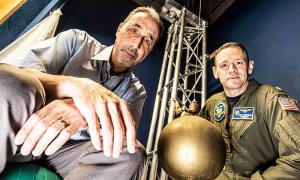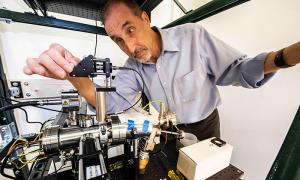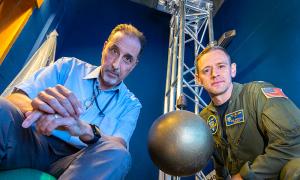
NPS Atomic Fountain for Research in Quantum Sensing, Nears Completion of First Phase

Dr. Frank Narducci, professor and chair of the NPS Department of Physics, and doctoral student U.S. Navy Cmdr. Jens Berdahl are making progress on the installation of an atomic fountain at NPS in an unused elevator shaft. (U.S. Navy photo by Javier Chagoya)
NPS physicists are on track to bring a new atomic fountain online – the largest of its kind in the world – for applications to quantum sensing experiments.
MONTEREY, CALIFORNIA, UNITED STATES, November 25, 2024 /EINPresswire.com/ -- Naval Postgraduate School (NPS) physicists are on track to bring the institution’s new atomic fountain online – the largest of its kind in the world – for applications to quantum sensing experiments in precise navigation and timekeeping.
Using a Defense University Research Instrumentation Program (DURIP) award bestowed last year and plenty of elbow grease, Dr. Frank Narducci, Chair of the NPS Department of Physics, and his Ph.D. student U.S. Navy Cmdr. Jens Berdahl, a former Navy pilot currently pursuing his doctorate through the service’s Permanent Military Professor program, are nearing completion of the first phase of construction in what will be a superlatively precise atomic-based instrument.
The device will open the door for a host of defense applications of quantum sensing based on atom interferometry research in general and gyroscope, gravimeter, accelerometer and clock research specifically. This has the potential to provide alternative navigation means in GPS-denied environments as well as detect threats adversaries want to keep hidden.
“The work being conducted by Professor Narducci is an excellent example of the benefits of basic research in support of national defense,” said Dr. Kevin Smith, NPS Vice Provost for Research and Innovation. “This research is advancing our state of knowledge about quantum sensing in general but is also being pursued in the context of advanced sensors and the development of precision navigation and timing instrumentation, which is critical for future systems employment in contested environments.”
This combination of cutting-edge technology and research coupled with a defense focus is what defines the unique educational experience at NPS for its master’s and Ph.D. students, delivering a competitive advantage as called for in the Naval Education Strategy in technical disciplines directly relevant to modern naval warfighting.
Quantum science is one of 14 Critical Defense Technology Areas identified by the Office of the Under Secretary of Defense for Research and Engineering (OUSD R&E), which also funds the DURIP program. The Office of Naval Research (ONR) oversees the Navy’s portion of DURIP grants and competitively awards proposals to universities conducting high-quality, relevant research addressing naval-unique needs.
An atomic fountain is essentially an interferometer – a device that extracts information from determining interference – that tosses atoms up and down, not unlike a water fountain. By measuring minute fluctuations in gravity, for example, the device can reveal a treasure trove of information.
Lobbing cold atoms up in an ultra-high vacuum system and measuring how long they take to come down using wave properties of atoms give quantum sensors their extreme precision. To launch the atoms, two finely tuned lasers are directed at the atoms, one closer and one further from resonance (the frequency the atom “likes” to absorb).
Narducci explained that pushing the atoms with a single laser, the atoms will overheat. The design instead uses two low power lasers, that vary in frequency that has the effect of gently tossing the atoms up.
For their initial experiments, Narducci and Berdahl, along with other members of the growing research team, will use the atomic fountain to measure the period of a Foucault's Pendulum swinging in Spanagel Hall.
Doing so, however, is not so easy as watching it with a stopwatch in hand, Narducci noted.
“If I tell you to measure the swing of the pendulum, but you’re not allowed to look at it, how would you do it?” he asked. “One way to do it is the swinging of the pendulum changes the force of gravity on you; a very, very, very, very small amount, but it does change and the atomic fountain can measure that.”
Finding a location for the tower involved a clever application of re-employing a former elevator shaft in Spanagel Hall, the tallest building on the NPS campus.
Narducci and Berdahl are constructing the fountain there in two phases. The initial version, which Narducci terms a “baby fountain,” will measure nearly 12 feet (4 meters) in height; the final will stand approximately 100 feet (30 meters) tall.
While a taller fountain does imply greater sensitivity in general, bigger does not necessarily mean better when measuring a relatively small object like the pendulum: as the atoms get further and further away, the gravitational effect of the pendulum gets smaller and smaller. On the other hand, the baby fountain might not be tall enough to provide the best measurement. Having the range of a tall fountain affords maximum flexibility in determining the optimal configuration for experiments.
Furthermore, Narducci observed, taking measurements with a tall fountain is hardly field expedient.
“If we’re talking about taking this technology out into the field, we don’t have the luxury of taking a tall instrument out and putting it in the ground and letting it record for 24 hours, then move it two feet to record another 24 hours,” he said. “We would like to do this on operationally relevant timescales.”
This is precisely what Berdahl is conducting his Ph.D. work on.
“My dissertation is studying the atomic fountain and showing its precision over operationally relevant timescales. We’re trying to rapidly capture any changes to the gravitational acceleration vector,” he explained. “The time period that we’re hoping to resolve is the time that it takes for the pendulum to swing once. Overall, we are characterizing the possible precision we can achieve while constraining our system in allowed dwell times. That’s a challenge!”
Designed as a “user facility” with both on-site and virtual access planned, the atomic fountain will be completely automated and configurable via a web-based interface to connect with the Naval Research and Development Establishment (NR&DE) and other partners involved.
Ultimately, the atomic tower will be in the hands of NPS’ students and defense-expert faculty in 2025 who will be learning and working on it, offering unparalleled education and research opportunities.
Berdahl is immeasurably excited at the prospect of imparting this knowledge.
“Having a grounding in quantum mechanics and how we might use these technologies in the field – its capabilities and constraints – is everything for the leaders who are coming through NPS and moving on to different acquisition jobs, engineering or duty officers,” he said. “They have to understand what this environment in the future might look like, and that includes all the technologies that might be available.”
“That conversation is very, very different if you have quantum sensors than if you don’t,” Berdahl added.
Kristina Wiedemann
Naval Postgraduate School
+1 831-656-3567
email us here
Distribution channels: Education, Military Industry, Science, Technology
Legal Disclaimer:
EIN Presswire provides this news content "as is" without warranty of any kind. We do not accept any responsibility or liability for the accuracy, content, images, videos, licenses, completeness, legality, or reliability of the information contained in this article. If you have any complaints or copyright issues related to this article, kindly contact the author above.
Submit your press release

